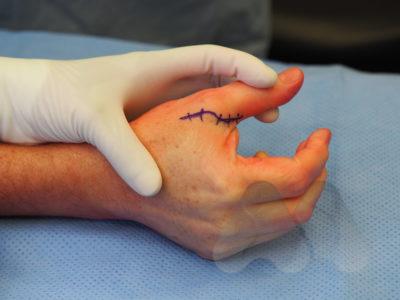What is it?
Skier’s or gamekeeper’s thumb is caused by a fall onto the thumb or a forceful pull of the thumb away from the palm. This results in a tear of the ulnar collateral ligament of the thumb metacarpophalangeal joint (MCPJ).
How do I know if I have a skier’s thumb?
You may have felt a pop or sharp pain on the inside of the thumb at the time of injury, followed by bruising and swelling in the area. Depending on the severity of the injury, pain may settle quickly or persist for a week or more. You may feel weak when performing strong gripping tasks such as opening jars or holding onto large heavy objects. A lump may develop on the inside of the thumb as the ligament scars or if some other tissue moves in-between the ligament and the bone (Stener lesion).
Your doctor may order an ultrasound scan which can diagnose the injury and exclude a Stener lesion which would require surgery.
What is the treatment?
Most injuries can be treated without surgery. A referral to hand therapist will be able to make a custom made splint to hold the thumb in position for 6-8 weeks whilst the ligament heals. If the thumb is very unstable, or if there is a Stener lesion, the ligament is unlikely to heal enough to provide stability to the thumb to restore a powerful grip. In these situations, an operation is required to reattach the ligament to the thumb bone. If the injury is chronic and there is a poor quality ligament, a spare tendon; usually taken from the forearm, is used to reconstruct the ligament.
What are the risks of surgery?
Risks of surgery include:
- Wound infection
- Injury to the nerves that supply the skin over the back of the thumb
- Stiffness of the thumb MCP joint movements.




